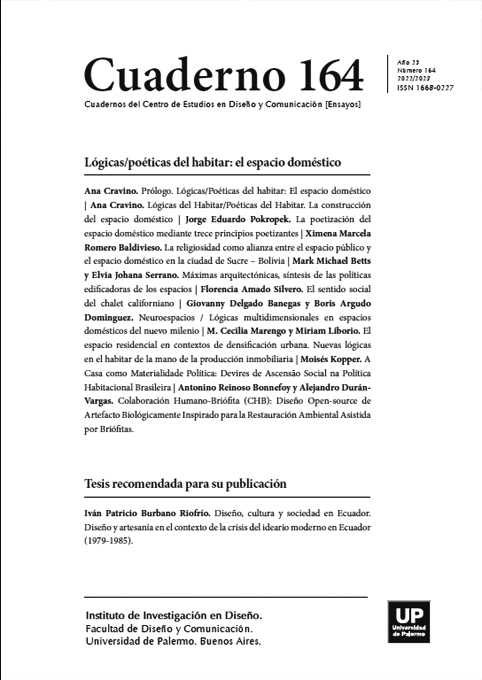A Casa como Materialidade Política: Devires de Ascensão Social na Política Habitacional Brasileira
Resumen
El artículo explora cómo la apertura de horizontes imaginativos del futuro está ligada a la apropiación y consumo de la casa propia entre los beneficiarios de las políticas de vivienda brasileñas.
Citas
Bachelard, G. (1958). The Poetics of Space: The Classic Look at How we Experience Intimate Places. Boston: Beacon Press Books.
Bessire, L. (2013). Behold the Black Caiman: A Chronicle of Ayoreo Life. Chicago; London: The University of Chicago Press.
Biehl, J., & Neiburg, F. (2021). Oikography: Ethnographies of House-ing in Critical Times. Cultural Anthropology, 36(4), 539–547.
Bourdieu, P. (2006). Argelia 60: Estructuras Económicas y Estructuras Temporales. Buenos Aires: Siglo XXI Editores Argentina.
_____ (1984). Distinction: A Social Critique of the Judgment of Taste. Cambridge: Harvard University Press.
_____ (2001). Las Estructuras Sociales de la Economía. Buenos Aires: Manantial.
Brand, S. (1994). How Buildings Learn: What Happens to them After They’re Built. Harmondsworth: Penguin.
Carsten, J., & Hugh-Jones, S. (1995). About the House: Lévi-Strauss and Beyond. Cambridge: Cambridge University Press.
Cieraad, I. (Ed.) (2006). At Home: An Anthropology of Domestic Space. Syracuse: Syracuse University Press.
Crapanzano, V. (2004). Imaginative Horizons: An Essay in Literary-Philosophical Anthropology. Chicago: University of Chicago Press.
Deleuze, G. (2006). Two Regimes of Madness: Texts and Interviews 1975-1995. Los Angeles: Semiotext(e).
Douglas, M. (1991). The Idea of a Home: A Kind of Space. Social Research, 58(1), 287–307.
Foucault, M. (1979). A Governamentalidade. In M. Foucault. Microfísica do Poder (pp. 277-293). Rio de Janeiro: Graal.
Gordillo, G. (2014). Rubble: The Aftermath of Destruction. Durham; London: Duke University Press.
Gordon Jr, C. (1996). Resenha de ‘About the House: Lévi-Strauss and Beyond.’ Mana, 2, 192–195.
Han, C. (2011). Symptoms of Another Life: Time, Possibility and Domestic Relations in Chile’s Credit Economy. Cultural Anthropology, 26(1), 7–32.
Ingold, T. (2011). Being Alive: Essays on Movement, Knowledge and Description. New York: Routledge.
_____ (2012). Trazendo as Coisas de Volta à Vida: Emaranhados criativos num mundo de materiais. Horizontes Antropológicos, 18(37), 25–44.
Kent, S. (1990). Domestic Architecture and the Use of Space. Cambridge: Cambridge University Press.
Kopper, M. (2019). House-ing Urban Kin: Family Configurations, Household Economies and Inequality in Brazil’s Public Housing. Articulo: (Journal of Urban Research), 20.
Lane, B. M. (2007). Housing and Dwelling: Perspectives on Modern Domestic Architecture. New York: Routledge.
Lévi-Strauss, C. (1986). A Noção de Casa. In: C. Lévi-Strauss. Minhas Palavras. São Paulo: Brasiliense.
Marcelin, L. H. (1999). A Linguagem da Casa entre os Negros no Recôncavo Baiano. Mana, 5(2), 31–60.
_____ (2015). Violence, Human Insecurity and the Challenge of Building Haiti: A Study of a Shantytown in Port-au-Prince, Haiti. Current Anthropology, 56(2).
Miller, D. (2001). Home Possessions: Material Culture Behind Closed Doors. New York: Routledge, 2001.
_____ (2009). The Comfort of Things. Cambridge: Polity Press.
_____ (ed.). (2005). Materiality. Durham; London: Duke University Press.
Navaro-Yashin, Y. (2012). The Make-Believe Space: Affective Geography in a Postwar Polity. Durham; London: Duke University Press.
Oliver, P. (2007). Dwellings: The Vernacular House Worldwide. Phaidon Press.
Petryna, A. (2018). Wildfires at the Edges of Science: Horizoning Work amid Runaway Change. Cultural Anthropology, 33(4), 570–595.
Rapoport, A. (1969). House Form and Culture. Hoboken: Prentice Hall.
Salata, A. (2012). A Nova Classe Média Brasileira: Contribuição para um Debate Politico. Rio de Janeiro: Observatório das Metrópoles.
Sigmund, F. (2003). The Uncanny. London: Penguin Books.
Souza, J. (2009). A Ralé Brasileira: Quem é e Como Vive. Belo Horizonte: Editora UFMG.
_____ (2010). Os Batalhadores Brasileiros: Nova Classe Média ou Nova Classe Trabalhadora? Belo Horizonte: Editora UFMG.
Zelizer, V. (1994). The Social Meaning of Money: Pin Money, Paychecks, Poor Relief, and Other Currencies. Princeton: Princeton University Press.
Los autores/as que publiquen en esta revista ceden los derechos de autor y de publicación a "Cuadernos del Centro de Estudios de Diseño y Comunicación", Aceptando el registro de su trabajo bajo una licencia de atribución de Creative Commons, que permite a terceros utilizar lo publicado siempre que de el crédito pertinente a los autores y a esta revista.


